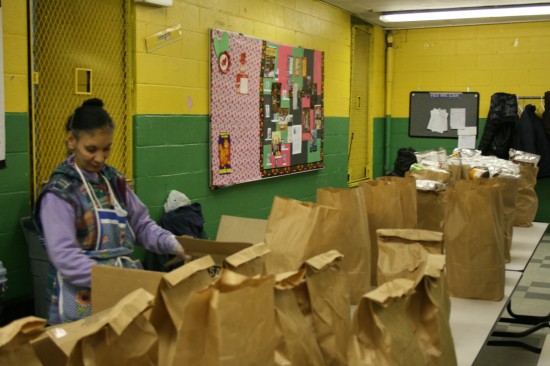
When a recent Gallup poll found that the 16th Congressional District, which includes Mott Haven, Melrose and Port Morris, has the highest rates of hunger in the nation, Jordan wasn’t surprised. “It’s only expected in difficult times that the poor get poorer,” he said.
Food pantries in Mott Haven have been struggling in the past year to deal with increased demand. According to the Gallup survey, 36.9 percent of residents in Rep. Jose Serrano’s South Bronx district said there were times in 2009 when they did not have enough money to buy food they needed.
The growing need is forcing emergency food agencies to make tough decisions: decrease handouts, cut back operating hours or even turn people away.
Hunger in the area has grown tremendously since Jordan started at Saint Benedict’s 10 years ago. He estimated that the Mott Haven center has seen about a 48 percent increase in use of its emergency food programs in the past year.
The toughest times are late in the month, when residents’ food stamps and Social Security checks are running out.
“We have had to turn people away,” Jordan said. “If we do have a day that we have very limited resources, we try to redirect the family to come in when we expect a delivery or a donation from one of our partners so we can restock our shelves.”
Saint Benedict’s is not alone. In 2009, 58 percent of Bronx emergency food providers said they had turned people away, according to the New York Coalition Against Hunger’s Annual Hunger Survey.
United Bronx Parents, a food pantry on Prospect Avenue and East 163rd Street, is trying to avoid that, said Christian Estrada, assistant director of kitchens. He, too, has seen a drastic increase, with more seniors, families with children and adults with jobs coming for emergency food service.
To deal with the increase, the pantry often has to resort to rationing, giving out less to each hungry person, Estrada said.
“The overall need we’re facing—none of us are even close to meeting the tremendous demand,” said Joel Berg, executive director of the Coalition Against Hunger, which represents over 1200 emergency food agencies across the city. Two of out every three pantries in the Bronx did not have enough food to meet the demand in 2009—the highest percentage in the city, according to Berg.
The impact of hard times is also evident at St. Ann’s Episcopal Church on St. Ann’s Avenue and East 140th Street. Ten minutes before the church’s pantry opened on a cold February morning, 16 people were waiting outside, equipped with shopping carts, black plastic bags and boxes to fill with the food they’d receive.
Gladys C., a Mott Haven resident who happened to see the line that morning, brought home food from St. Ann’s for the first time. A native of Ecuador, she said she cannot go to most pantries because she doesn’t have documentation. “But here, thank God, they didn’t ask me for anything, and they helped me,” she said.
The 68-year-old lives with her daughter and grandson. “Right now it’s very difficult,” she said in Spanish. “My daughter has a little work, but earns very little.”
In the past few months the number of clients at the pantry has gone up 50 percent, said Reverend Martha Overall, the church’s pastor, who has been at St. Ann’s for 17 years. The pantry now serves about 140 families in a day.
Despite the high demand and the increasing price of food, St. Ann’s does not ask about immigration status, and refuses to cut back operating hours or turn people away. Instead, like United Bronx Parents, St. Ann’s resorts to rationing.
“We reduce the amount of food that we give people when necessary,” Overall said. “I don’t like to turn anybody away because that may mean a child is not being fed.”
Raul Alcantara, 58, has been coming to St. Ann’s for a year. The retired maintenance worker receives too much money from Social Security disability and his pension to qualify for food stamps, but not enough to buy the food he needs. So he goes to eight different pantries throughout the month, he said.
“We all get broke sometimes, so this is helpful,” he said. “At least we get something to eat.”
A version of this story appeared in the April 2010 issue of the Mott Haven Herald.

[…] Read the rest at The Mott Haven Herald […]